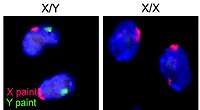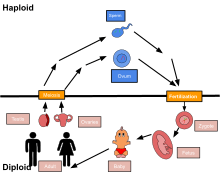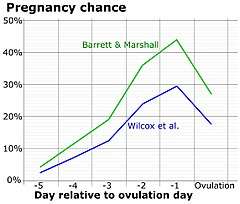Human reproduction
Human reproduction is any form of sexual reproduction resulting in human fertilization. It typically involves sexual intercourse between a man and a woman. During sexual intercourse, the interaction between the male and female reproductive systems results in fertilization of the woman's ovum by the man's sperm. These are specialized reproductive cells called gametes, created in a process called meiosis. While normal cells contains 46 chromosomes, 23 pairs, gamete cells only contain 23 chromosomes, and it is when these two cells merge into one zygote cell that genetic recombination occurs and the new zygote contains 23 chromosomes from each parent, giving them 23 pairs. A typical 9-month gestation period is followed by childbirth. The fertilization of the ovum may be achieved by artificial insemination methods, which do not involve sexual intercourse. Assisted reproductive technology also exists.
| Part of a series on |
| Sex |
|---|
 |
| Biological terms |
| Sexual reproduction |
|
| Sexuality |
Anatomy

Human male
The male reproductive system contains two main divisions: the testes where sperm are produced, and the penis. In humans, both of these organs are outside the abdominal cavity. Having the testes outside the abdomen facilitates temperature regulation of the sperm, which require specific temperatures to survive about 2-3 °C less than the normal body temperature i.e. 37 °C. In particular, the extraperitoneal location of the testes may result in a 2-fold reduction in the heat-induced contribution to the spontaneous mutation rate in male germinal tissues compared to tissues at 37 °C.[1] If the testicles remain too close to the body, it is likely that the increase in temperature will harm the spermatozoa formation, making conception more difficult. This is why the testes are carried in an external pouch viz. scrotum rather than within the abdomen; they normally remain slightly cooler than body temperature, facilitating sperm production.
Human female
The female reproductive system likewise contains two main divisions: the vagina and the Ovum.
The ovum meets with sperm cell, a sperm may penetrate and merge with the egg, fertilizing it with the help of certain hydrolytic enzymes present in the acrosome. The fertilization usually occurs in the oviducts, but can happen in the uterus itself. The zygote then becomes implanted in the lining of the uterus, where it begins the processes of embryogenesis and morphogenesis. When the fetus is developed enough to survive outside of the uterus, the cervix dilates and contractions of the uterus propel it through the birth canal, which is the vagina.
The ova, which are the female sex cells, are much larger than the spermatozoon and are normally formed within the ovaries of the female fetus before its birth. They are mostly fixed in location within the ovary until their transit to the uterus, and contain nutrients for the later zygote and embryo. Over a, usually, regular interval known as the menstrual cycle, in response to hormonal signals, a process of oogenesis matures one ovum which is released and sent down the Fallopian tube. If not fertilized, this egg is flushed out of the system through menstruation.
Process of fertilization


Human reproduction normally begins with copulation, followed by nine months of pregnancy before childbirth, though it may be achieved through artificial insemination. Many years of parental care are required before a human child becomes independent, typically between twelve and eighteen or more. Pregnancy can be avoided with the use of contraceptives such as condoms and Intrauterine devices.
Copulation
Human reproduction naturally takes place as internal fertilization by sexual intercourse. During this process, the male inserts his penis, which needs to be erect, into the female's vagina, and then either partner initiates rhythmic pelvic thrusts until the male ejaculates semen, which contains sperm, into the vaginal canal. This process is also known as "coitus", "mating", "having sex", or, euphemistically, "making love". The sperm and the ovum are known as gametes (each containing half the genetic information of the parent, created through meiosis). The sperm (being one of approximately 250 million sperm in a typical male ejaculation) travels through the vagina and cervix into the uterus or Fallopian tubes. Only 1 in 14 million of the ejaculated sperm will reach the Fallopian tube. The egg simultaneously moves through the Fallopian tube away from the ovary. One of the sperm encounters, penetrates and fertilizes the ovum, creating a zygote. Upon fertilization and implantation, gestation of the fetus then occurs within the female's uterus.[2][3][4][5]

Pregnancy rates for sexual intercourse are highest during the menstrual cycle time from some 5 days before until 1 to 2 days after ovulation.[7] For optimal pregnancy chance, there are recommendations of sexual intercourse every 1 or 2 days,[8] or every 2 or 3 days.[9] Studies have shown no significant difference between different sex positions and pregnancy rate, as long as it results in ejaculation into the vagina.[10]
Alternative methods
As an alternative to natural sexual intercourse, there exists artificial insemination, where sperm is introduced into the female reproductive system. There are also many methods of assisted reproductive technology, such as in vitro fertilization, where one or more egg cells are retrieved from a woman's ovaries and co-incubated with sperm outside the body. The resulting embryo can then be reinserted into the woman's womb.
Pregnancy
Pregnancy is the period of time during which the fetus develops, dividing via mitosis inside the female. During this time, the fetus receives all of its nutrition and oxygenated blood from the female, filtered through the placenta, which is attached to the fetus' abdomen via an umbilical cord. This drain of nutrients can be quite taxing on the female, who is required to ingest slightly higher levels of calories. In addition, certain vitamins and other nutrients are required in greater quantities than normal, often creating abnormal eating habits. Gestation period is about 266 days in humans. While in the uterus, the baby first endures a very brief zygote stage, then the embryonic stage, which is marked by the development of major organs and lasts for approximately eight weeks, then the fetal stage, which revolves around the development of bone cells while the fetus continues to grow in size.[11]
Birth

Once the fetus is sufficiently developed, chemical signals begin the process of birth, which begins with the fetus being pushed out of the birthing canal. The newborn, which is called an infant in humans, should typically begin respiration on its own shortly after birth. Not long after, the placenta eventually falls off on its own. The person assisting the birth may also sever the umbilical cord.
Parental care
A human baby is nearly helpless and the growing child requires high levels of parental care for many years. One important type of early parental care is lactation, feeding the baby milk from the mother's mammary glands in her breasts.[12]
See also
References
- Baltz RH, Bingham PM, Drake JW (1976). "Heat mutagenesis in bacteriophage T4: The transition pathway". Proc. Natl. Acad. Sci. USA. 73 (4): 1269–1273. Bibcode:1976PNAS...73.1269B. doi:10.1073/pnas.73.4.1269. PMC 430244. PMID 4797.CS1 maint: multiple names: authors list (link)
- Ghazal, S, Kulp Makarov, J; et al. (2014). "Egg Transport and Fertilization". The Global Library of Women's Medicine. doi:10.3843/GLOWM.10317. ISSN 1756-2228. Retrieved May 8, 2016.CS1 maint: multiple names: authors list (link)
- "Conception: How It Works". The Regents of The University of California. 2002. Retrieved May 8, 2016.
- "Fertility Basics". Complete Fertility Centre Southampton. Complete Fertility Ltd. 2015. Retrieved May 8, 2016.
- "Conception & Pregnancy: Ovulation, Fertilization, and More". WebMD, LLC. 2016. Retrieved May 8, 2016.
- Dunson, D.B.; Baird, D.D.; Wilcox, A.J.; Weinberg, C.R. (1999). "Day-specific probabilities of clinical pregnancy based on two studies with imperfect measures of ovulation". Human Reproduction. 14 (7): 1835–1839. doi:10.1093/humrep/14.7.1835. ISSN 1460-2350. PMID 10402400.
- Pages.242,374 in: Weschler, Toni (2002). Taking Charge of Your Fertility (Revised ed.). New York: HarperCollins. pp. 359–361. ISBN 0-06-093764-5.
- "How to get pregnant". Mayo Clinic. 2016-11-02. Retrieved 2018-02-16.
- "Fertility problems: assessment and treatment, Clinical guideline [CG156]". National Institute for Health and Care Excellence. Retrieved 2018-02-16. Published date: February 2013. Last updated: September 2017
- Dr. Philip B. Imler & David Wilbanks. "The Essential Guide to Getting Pregnant" (PDF). American Pregnancy Association. Archived from the original (PDF) on 2018-06-01. Retrieved 2018-02-16.
- Feist, Gregory J.; Rosenberg, Erika L. (11 October 2011). Psychology: Perspectives and Connections (Second ed.). McGraw Hill. pp. (171–172). ISBN 978-0-07-803520-3.
- Sexual Reproduction in Humans. 2006. John W. Kimball. Kimball's Biology Pages, and online textbook.
Further reading
- Hopwood, Nick, Rebecca Flemming, Lauren Kassell, eds. Reproduction: Antiquity to the Present Day (Cambridge UP, 2018). Illustrations. xxxv + 730 pp. ISBN 978-1-107-06802-5 excerpt also online review 44 scholarly essays by historians.